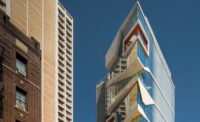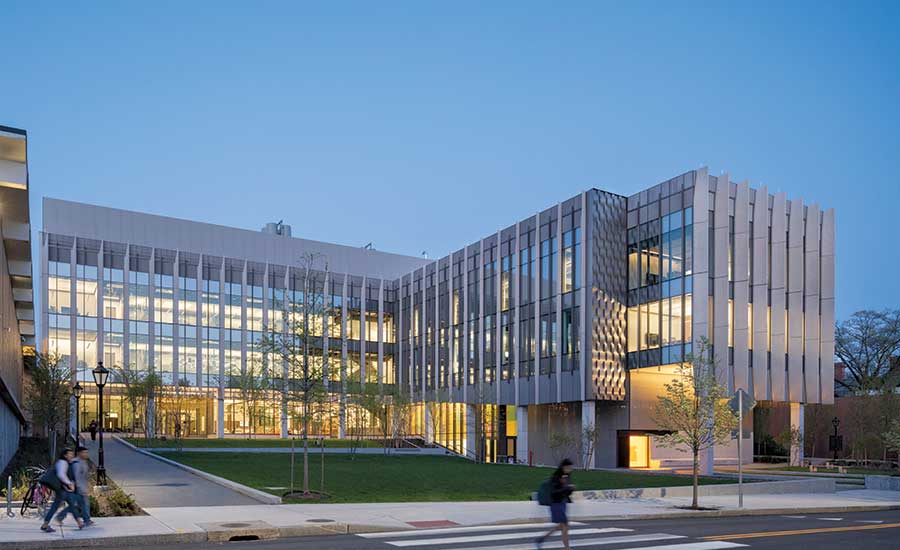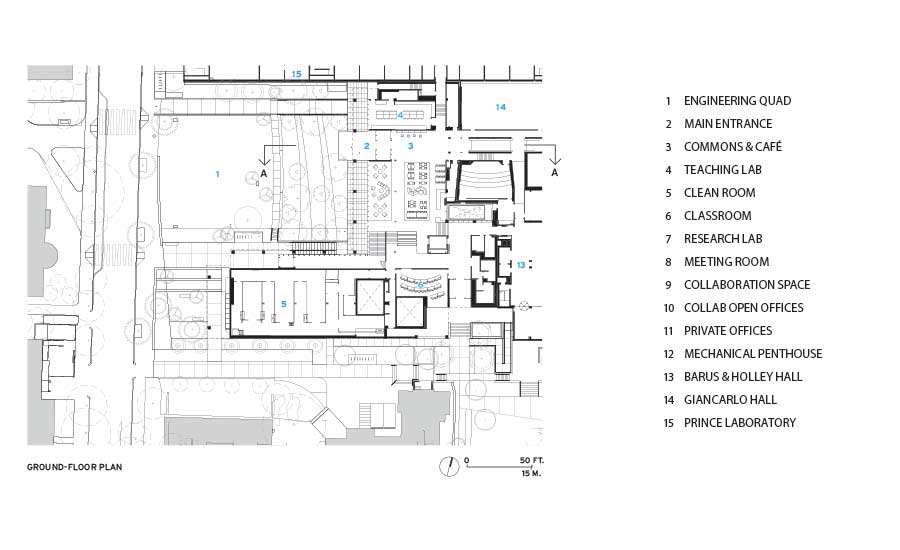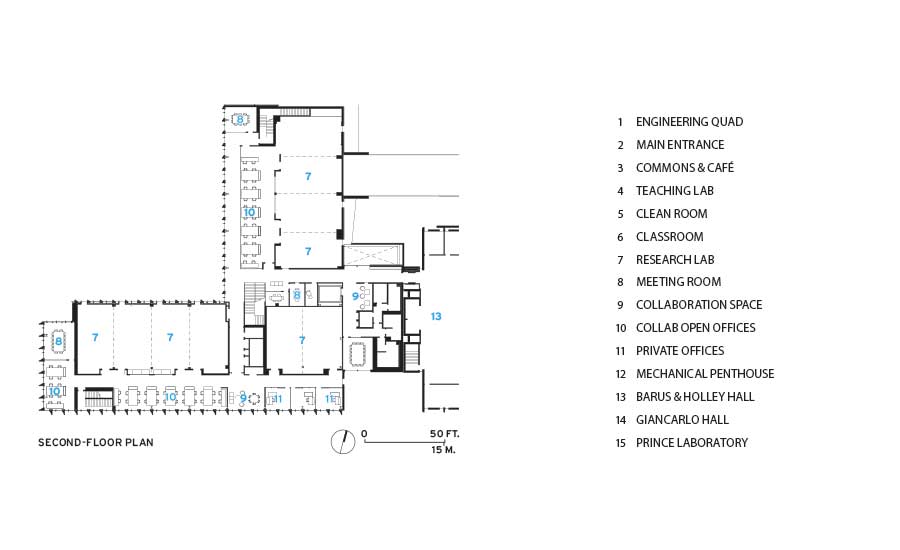Brown University Engineering Research Center by KieranTimberlake
Providence, Rhode Island

The ERC’s L shape defines a gently sloping lawn.
Photo © Peter Aaron/Otto

Although it reads as a glass building, the skin includes GFRC fins, expanded metal mesh, aluminum rainscreen, and granite cladding. An amber-tinted window provides a view into a clean room.
Photo © Peter Aaron/Otto

The GFRC fins vary from 12 to 30 inches deep, according to their solar orientation.
Photo © Peter Aaron/Otto

The ERC connects to three existing engineering department structures, including the 1960s Barus & Holley Hall.
Photo © Peter Aaron/Otto

Much of the first floor is devoted to a commons space that looks out onto the new quad.
Photo © Peter Aaron/Otto

Upstairs, utilities run exposed above circulation spaces while researchers’ open office areas flank the labs.
Photo © Peter Aaron/Otto

Upstairs, utilities run exposed above circulation spaces while researchers’ open office areas flank the labs.
Photo © Warren Jagger

One of nine pieces created by artist Spencer Finch for the ERC occupies a doublestory clean room corridor.
Photo © Warren Jagger

Image courtesy KieranTimberlake

Image courtesy KieranTimberlake

Image courtesy KieranTimberlake











Architects & Firms
You could assume that a new laboratory building for an Ivy League institution would be state-of-the-art. So it is not surprising that Brown University’s recently completed $88 million Engineering Research Center (ERC) provides top-notch facilities. The three-story, 81,000-square-foot building, designed by the Philadelphia firm KieranTimberlake, sits near the eastern edge of the Providence, Rhode Island, campus and contains 22 highly flexible laboratories, a set of clean rooms for the study of nanoscale materials, microelectronics, and photonics, and a high-performance imaging suite.
Additional Content:
Jump to credits & specifications
Yet what makes the ERC stand out is not its inventory of sophisticated equipment but the project’s lofty goal to contribute to the larger campus environment. The ambition, says Larry Larson, the engineering school’s dean, “was to enhance community and enhance research.”
For the architects, this meant making the most of the ERC’s location at the terminus of a series of contiguous quadrangles leading from Brown’s main green, where the 250-year-old university’s most historic buildings are clustered. “A site at the end of this axis seemed like a real obligation,” says Stephen Kieran, KieranTimberlake partner. Taking this responsibility seriously, Kieran and his team opted to extend the succession of green spaces. Together with the low-slung 1960s Prince Engineering Lab (one of three existing structures to which the new building is attached), the L-shaped ERC frames a grassy, gentle slope.
The new research facility and its outdoor public space replace four late 19th- and early 20th-century single-family dwellings that had housed various academic departments. But what dominated the site before construction of the ERC was the seven-story windowless brick end elevation of Barus and Holley, a lab and faculty office building from the same era as Prince. Now, however, instead of a looming, blank masonry wall, anyone approaching from the older campus on a mild day encounters students lounging on the lush lawn and an inviting transparency: the ERC almost completely obscures the much taller older building with a lively facade that includes vertical glass fiber reinforced concrete (GFRC) shading fins, expanded metal mesh scrims, aluminum composite panels, and insulated spandrel glass, along with clear glazing. And as people get closer, elements like a window into a ground-floor clean room—with its glowing, UV-filtering amber glass—provide clues about what kind of work goes on inside. “So many science buildings are mute,” says Kieran, “and they don’t need to be.”
Just beyond an arcade of granite-clad columns, the social space continues inside the building with a generous commons and café that occupy most of the ground floor. Here the exposed steel structure and 15-foot-tall ceilings create a loft-like feel, while tables and chairs and cushioned seating provide areas for studying or taking a break overlooking the new quad. According to Larson, the spot—named for engineering professor emeritus Barrett Hazeltine, whose course on entrepreneurship was hugely popular with liberal arts students for decades—attracts graduate and undergraduate students from all over campus, not just engineers.
Upstairs are most of the real workhorse spaces, including easily reconfigurable labs flanked by “collab” open-office research areas. Here, polished concrete floors highlight circulation, while HVAC systems and the copious utilities for the laboratories are neatly organized and visible overhead. But Kieran says he would not have had the confidence to leave these elements exposed had it not been for the integrated project delivery agreement among client, firm, and contractor, which allowed closer collaboration with trade partners and enabled successful meshing of design intent and constructability.
The architects clearly made sure the less than sexy aspects of the building were right, but not at the expense of the architectural details, such as an open stair that connects all levels. It skillfully combines balustrades of glass or folded steel plate with wooden handrails and open-riser terrazzo treads.
The intense study that went into the building envelope is also obvious. The depth of its GFRC fins, which help control heat gain and glare, have been tuned through solar analyses to each facade’s orientation. KieranTimberlake built the first of many visual and performance mockups in the firm’s own fabrication shop in its large Philadelphia office (in a former beer-bottling plant). Although the assembly appears to be primarily glass, it is in fact an unusual hybrid of a unitized curtain wall and a rainscreen system, thus improving its thermal properties. The skin is one of several features that have put the ERC on track to earn LEED Gold, including active chilled beams, outdoor air heat recovery, and an all-LED lighting system controlled by occupancy and daylight sensors.
This focus on energy savings is just one more facet of the smartly designed and expertly realized ERC. It is another way the building goes beyond promoting the most advanced engineering to create an amenity for the entire university community and to enhance—with contemporary architecture—an historic New England campus.
CreditsArchitect: KieranTimberlake, 841 N. American Street, Philadelphia, PA 19123, 215-922-6600, www.kierantimberlake.com
Personnel in architect's firm who should receive special credit: Stephen Kieran FAIA, Jason Smith AIA, Laurent Hedquist AIA, Mark Davis AIA, Elizabeth Kahley AIA, Steven Johns AIA, Rachel Stoudt AIA, Eli Allen AIA
Architect of record: KieranTimberlake
Interior designer: KieranTimberlake
Engineers: Electrical: BuroHappold with E.W. Audet & Sons Mechanical: BuroHappold with Arden Engineering Constructors and Worcester Air Plumbing: BuroHappold with Arden Engineering Constructors Structural: BuroHappold with Ocean Steel and John Strafach & Sons Civil: Vanasse Hangen Brustlin with Digregorio
Consultants: Laboratory and Cleanroom Design: Research Facilities Design with Northeast Interior Systems and F.H. Chase Landscape Architect: Gustafson Guthrie Nichols with Schumacher Sustainability: Vidaris Façade: BuroHappold with Massey’s Plate Glass & Aluminum and Grande Masonry
General contractor: Shawmut Design and Construction,
Photographer: Peter Aaron, Warren Jagger |
SpecificationsStructural System Manufacturer of any structural components unique to this project: Canam – Reveal Composite Acoustic Deck with Reveal LOK integrated dovetail hanging system
Exterior Cladding Masonry: Grande Masonry Metal panels: Metal/glass curtain wall: Massey’s Plate Glass and Aluminum (Installer for unitized curtainwall and GFRC) Rainscreen: QC Facades (Glass rainscreen panels) Precast concrete: Arc Limited (GFRC) EIFS, ACM, or other: ACM fabricated and installed by All Panel Systems (ACM material supplied by Alpolic) Moisture barrier: Henry AirBloc Curtain wall: United Architectural Metals (custom unitized curtainwall supplier) Other cladding unique to this project: QC Facades (Woven metal wall panels)
Roofing Built-up roofing: SikaSarnafil, Installed by Apollo Roofing and Sheet Metal
Glazing Glass: Viracon
Doors Wood doors: Eggers Industries Sliding doors: Stanley Access Technologies Special doors: Krieger Sound Control Doors, Stanley Automatic Sliding Glass Doors
Hardware Locksets: Arrow Lock, Stanley Security Solutions Closers: LCN Closers Exit devices: Stanley Security Solutions Pulls: Rockwood Security devices: Stanley Security Solutions
Interior Finishes Acoustical ceilings: Armstrong Ultima Suspension grid: Armstrong Interlude Demountable partitions: DIRTT Cabinetwork and custom woodwork: Millwork One Paints and stains: Sherwin-Williams Wall coverings: Forbo Pinboard Paneling: Gordon Inc. Aluminum Wall Panels Plastic laminate: Formica ColorCore Solid surfacing: Corian Special surfacing: QuartzStone Floor and wall tile: Caesar Slab (floor); CESI Ceramica (wall) Resilient flooring: Tarkett iQ Optima Carpet: Mannington Boucle Special interior finishes unique to this project: Kaswell End Grain Wood Block Flooring, Stonhard Epoxy Flooring. Cleanroom fit-out by FH Chase.
Furnishings Office furniture: Knoll - Antenna Reception furniture: Knoll – K. Modular, Dividends Tables; Keilhauer - Dash Chairs: Knoll – Chadwick; Keilhauer – Filo Chair; Arper – Juno; Adreu World – Flex; Davis – Gingko Lounge Tables: Knoll - Dividends Upholstery: Knoll Other furniture: Laboratory casework by Northeast Interior Systems (NEIS), Cleanroom fitout by FH Chase.
Lighting Interior ambient lighting: Interior Linear Fixtures: Philips Ledalite, Laboratory Linear Fixtures: Cree Downlights: Commons Pendants: V2 Lighting Group, Commons Lounge Pendants: Architectural Lighting Works Exterior: Façade Fixtures: Ecosense, Tree Uplights: BK Lighting Dimming system or other lighting controls: Control System: Wattstopper
Conveyance Elevators/escalators: ThyssenKrup Elevator Americas
Plumbing Toilet room Fixtures: TOTO USA – High efficiency “water sense” toilet room fixtures Vacuum pumps and Air Compressors: Atlas Copco Water heaters: PVI boiler water heat exchangers- Aquaplex technology Nitrogen generation: Parker- High reliability
Energy Energy management or building automation system: Brown University Campus BAS Other unique products that contribute to sustainability:
Add any additional building components or special equipment that made a significant contribution to this project:
Design Annual energy consumption of 144 kbtu/sf EUI, 27% energy cost savings vs baseline |


















